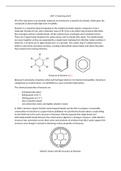UNIT 14 learning aim B
All of the ring atoms in an aromatic molecule are involved in a network of pi bonds, which gives the
compound an abnormally high level of stability.
Benzene is a colourless liquid recognized as the simplest aromatic organic compound. It has a
molecular formula of C6H6 and a molecular mass of 78. It has a six-carbon ring structure that looks
like a hexagon and has 3 double bonds. All the carbons have a hydrogen atom bonded to them.
There are 6 sigma bonds between the carbon atoms and 3 pi bonds that rotate. The double bonds
are never together as they are separated by a single bond. Implying from this that carbon contains 4
electrons, 3 of which are in sigma bonds and 1 in a pi bond. The carbon ring's P orbitals have the
ability to spin below and above its plane, creating a delocalized system below and above the plane
that contains free-moving electrons.
Structure of benzene pic 1
Because it exclusively comprises carbon and hydrogen atoms in its chemical composition, benzene is
categorised as a hydrocarbon. it is identified as a pure aromatic hydrocarbon.
The chemical properties of benzene are
- Petroleum-like odour
- Boiling point of 80 oC
- Melting point of 5.5 oC
- Clear colourless liquid
- Less dense than water and slightly soluble in water.
In 1865 a German organic chemist named August Kekulé was the first to propose a reasonable
construction for benzene in a paper that he published. He said that he dreamt about a snake biting
its tail which led to the cyclic structure of benzene. Kekulé proposed that single bonds and
alternating double bonds between the carbon atoms aligned in a hexagon. However, while Kekulé’s
structure was somewhat correct there were several pieces of evidence that didn’t quite support this
structure even though it assisted in disclosing various properties of benzene.
Kekulé’s dream and the structure of benzene
,According to Kekulé's structure, benzene has a carbon-carbon double and single bond, with the
double bond length being roughly 135pm and the single bond length being approximately 147pm.
Given that benzene's bonds are equal at around 140 pm, this shows that Kekulé was mistaken. The
pi-electron system is limitless and uniformly dispersed, and all carbon-carbon bonds are the same
length. The construction of Kekulé does not depict this.
Benzene often has alternating sigma and pi bonds; as a result, resonance occurs, making it the most
stable and aromatic substance. Because of resonance, all of the bonds in benzene's carbon atoms
are sp2 hybridised and the same length. According to Kekulé, the oscillating alternate bonds caused
benzene to consist of two rings with different alternate C-C bonds that were on the opposing sides
of the equilibrium. Contrary to Kekulé's theory of two oscillating structures, research by a scientist
by the name of Boffins revealed that while benzene has two distinct constructions, they coexist as an
intermediate with a lower energy than either of the two.
In 1931 a chemist named Linus Pauling proposed his resonance theory that explained the stability of
the delocalised electrons and why benzene undergoes mainly electrophilic substitution reactions.
Hence it was stated that instead of the Kekulé’s structure with alternating pi bonds a single structure
with the delocalized electrons shown on paper as a circle.
The problems with Kekulé’s structure were hinted at when it was supposed that the enthalpy of
hydrogenation of benzene was found not to be three times the value found for cyclohexane with its
one double carbon bond. The energy missing of hydrogenation is called resonance energy and that is
used to measure benzenes stability.
Hybridisation
According to the theory, the 6 pi electrons that make up the 3 localised double bonds would be
delocalized around the ring by overlapping the p orbitals. Since there would be no double bonds to
add to, all bonds would be equal. Furthermore, it provided a flat structure. By forming three C-C
double bonds instead of distributing the electrons uniformly among the carbon atoms, this structure
deviates from Kekulé's.
one way to overlap another delocalised pi
6 single bonds adjacent p orbitals possibility orbital system
, Thermochemical analysis
Unsaturated hydrocarbons are converted to the equivalent saturated molecule, which releases
energy. The enthalpy of hydrogenation may be calculated if the experiment is conducted in a bomb
calorimeter.
120kJ of energy is released per mole during the reduction of cyclohexane to cyclohexane.
C6H10(g) + H2(g) → C6H12(l)
When reduced to cyclohexane, benzene should release 360kJ per mole if it hypothetically had three
distinct C=C bonds..
C6H6(l) + 3H2(g) → C6H12(l)
When reduced, benzene generates 208 kJ per mole, moving it down the energy scale. This amount,
known as resonance energy, is 152kJ per mole more stable than anticipated.
X-Ray Diffraction
The single carbon-carbon bond lengths in cyclohexene were determined using crystal X-ray
diffraction patterns and were found to be 0.154nm. The atoms in the molecule scatter the rays,
which results in an electron diffraction pattern. The bond length of the C=C bond in cyclohexene was
also measured using the same approach and seemed to be 0.133nm. If Kekulé's structure is right,
the alternating C=C and C-C bonds have distinct lengths. However, when the bond lengths of
benzene molecules were estimated using the same method, they all came out to be the same length
of 0.139nm. This rules out alternating double and single carbon-carbon bonds, which is what they
must be. This offered proof that the benzene model proposed by Kekulé was incorrect.




